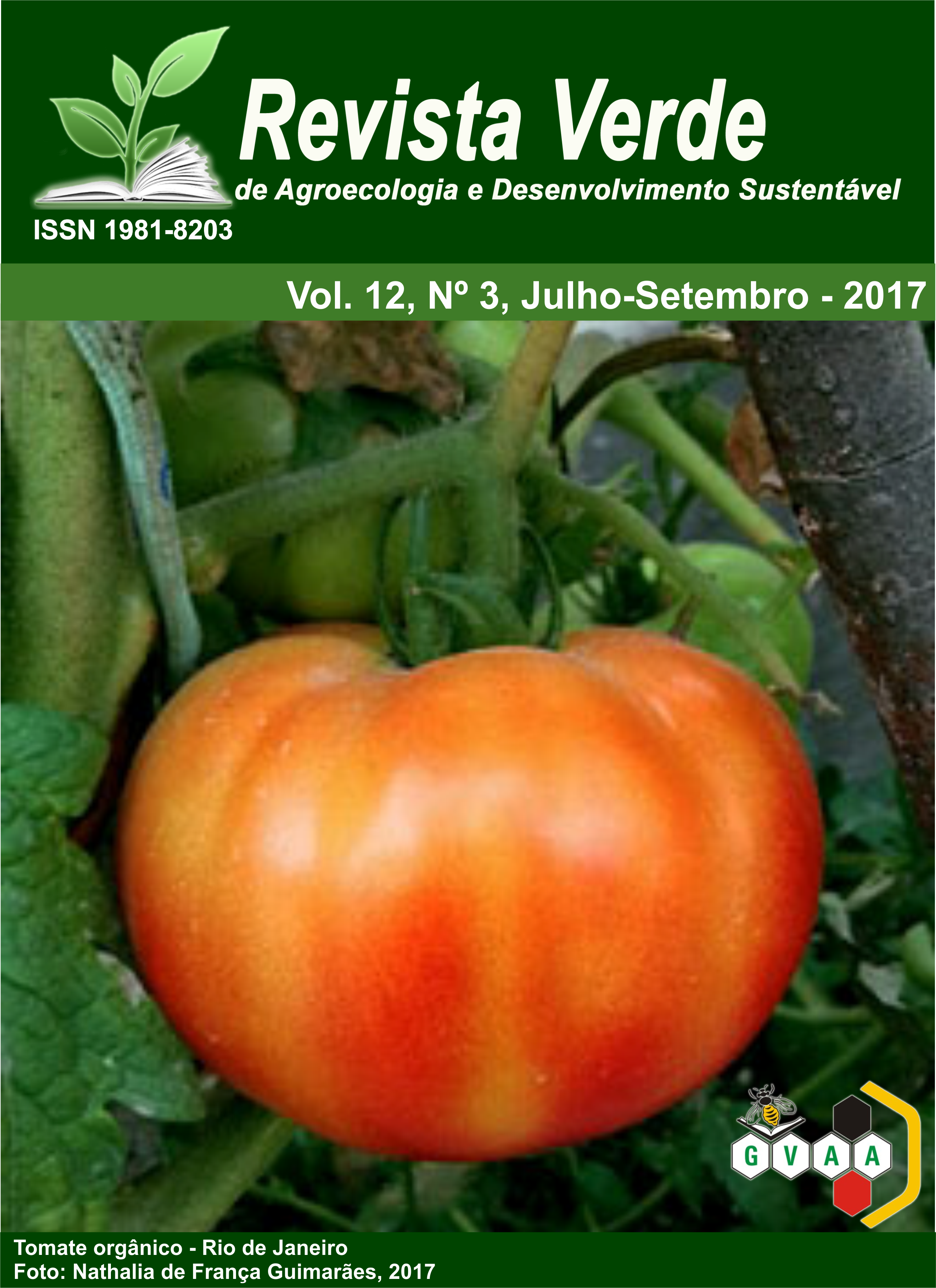Assisted selection in the improvement of soy for human consumption in the State of Tocantins
DOI:
https://doi.org/10.18378/rvads.v12i3.4593Keywords:
Glycine max, Heredity, Better Flavor.Abstract
Soy in human food has several health benefits, but finds resistance to its consumption by the western ones due to the flavor caused by the lipoxygenases enzymes. The objective of this study was to select soybean TN (Triple Null) hybrids in a population of the fourth self-fertilization cycle (F4) using techniques that use molecular markers. The experiment was conducted in the experimental area of the Federal University of Tocantins Campus Gurupi - TO. Hybridizations between soybean progenitors adapted to Tocantins and TN were performed. Obtained the F1 population in the greenhouse, F2, F3 and F4 were planted in the field, in the F4 generation was selection of superior hybrid for DNA analysis in order to identify hybrids with the trait complete absence of Lox2 and 3. We selected one hundred seventy-one hybrid, made up of DNA extraction and PCR of all. It was concluded that the highest percentage of TN hybrids was obtained at the intersection BRSMG 790A (TN) X GB874. Lox2 and Lox3 amplification primers confirmed as an essential tool in a soybean breeding program for human consumption. We selected 34 TN hybrids with the desired agronomic characteristics.
Downloads
References
ASTADI, I. R.; ASTUTI, M.; SANTOSO, U.; NUGRAHENI, P. S. In vitro antioxidant activity of anthocyanins of black soybean seed coat in human low density lipoprotein (LDL). Food Chemistry, v.112, p.659–663, 2009.
BRASILEIRO, A. C. M.; CARNEIRO, V. T. C. Manual de transformação genética de plantas. 2. ed. rev. ampl. Embrapa, Brasília, Brasil, 2015. 453p.
CHOI, I. Y.; HYTEN, D. L.; MATUKUMALLI, L. K.; SONG, Q. J.; CHAKY, J. M.; QUIGLEY, C. V.; CHASE, K.; LARK, K. G; REITER, R. S.; YOON, M. S.; Hwang, E. Y.; Yi, S. I.; Young, N. D.; SHOEMAKER, R. C.; TASSELL, C. P. V.; SPECHT, J. E.; CREGAN, P. B. A soybean transcript map: gene distribution, haplotype and single nucleotide polymorphism analysis. Genetics, Austin, v.176, p.685-696, 2007.
DANNER, M. A.; SASSO, S. A. Z.; BITTENCOURT, J. V. M.; CITADIN, I.; SACHET, M. R. Proposta de protocolo para extração de DNA de jabuticabeira. Ciência Florestal, Santa Maria, v.21, p.363-367, 2011.
DANTAS, M. I. S.; SILVA, M. G.; PINTO, C. R. R.; PEREIRA, C. A. S. P.; MINIM, V. P. R.; BITTENCOURT, M. C. B. Farinhas de soja sem lipoxigenase agregam valor sensorial em bolos. Revista Ceres, Viçosa, v.57, n.2, p.141-144, 2010.
DUFFY, C.; PEREZ, K.; PARTRIDGE, A. Implications of phytoestrogen intake for breast cancer. CA Cancer J Clinical, v.57, p.260-277, 2007.
FARIA, A. P.; FONSECA JÚNIOR, N. S. F.; DESTRO, D.; FARIA, R. T. Ganho genético na cultura da soja. Genetic gain in soybean crop, Semina: Ciencias Agrárias, Londrina, v.28, n.1, p.71-78, 2007.
JUHÁSZ, A. C. P.; CIABOTTI, S.; PÁDUA, G. P.; FAVORETO, L.; JESUS, A. M. S.; FRONZA, V. Melhoramento de Soja pra Alimentação Humana. Informe Agropecuário, Belo Horizonte, v.35, p.39-45, 2014.
KIM, M. Y.; HA, B. K.; JUN, T. H.; WANG, E. Y.; VAN, K.; KUK, Y.; LEE, S. Single nucleotide polymorphism discovery and linkage mapping of lipoxygenase-2 gene (Lx 2) in soybean. Euphytica, Philadelphia, v.135, p.169-177, 2004.
KIM, Y.S.; MOOM, J.K.; CHO, J.H.; KIM, H.T.; PARK, K.Y.; KIM, S.J. Improvement of special characters on three elite soybean cultivars by markers-assisted selection. Treatment Of Crop Science, Madison, v.7, p.197-210, 2006.
MACHADO, F. P. P.; QUEIRÓZ, J. H.; OLIVEIRA, M. G. A.; PIOVESAN, N. D.; PELUZIO, M. C. G.; COSTA, N. M. B.; MOREIRA, M. A. Effects of heating on protein quality of soybean flour devoid of Kunitz inhibitor and lectin. Food Chemistry, v.107, p.649-655, 2008.
NARVEL, J. M.; FEHR, W. R.; WELKE, G. A. Agronomic and seed traits of soybean lines lacking seed lipoxygenases. Crop Science, Madison, v.38, p.926-928, 1998.
OLIVEIRA, M. A.; CARRÃO PANIZZI, M. C.; MANDARINO, J. M. G.; LEITE, R. S.; CAMPOS FILHO, P. J.; VICENTINI, M. B. Quantificação dos teores de açúcares, oligossacarídeos e amido em genótipos/cultivares de soja (Glycine max (L) Merril) especiais utilizados na alimentação humana. Brazilian Journal of Food Technology, Campinas, v.13, p.23-29, 2010.
SANTOS, E. R.; BARROS, H. B.; CAPONE, A.; FERRAZ, E. C.; SANTOS, A. F.; FIDELIS, R. R. Divergência entre genótipos de soja, cultivados em várzea irrigada. Revista Ceres, Viçosa, v.58, n.6, p.755-764, 2011.
SILVA, C. O.; ANDRADE, G. F.; DANTAS, M. I. S.; COSTA, N. M. B.; PELUZIO, M. C. G.; FONTES, E. A. F.; MARTINO, H. S. D. Influência do processamento na qualidade proteica de novos cultivares de soja destinados à alimentação humana. Revista Nutrição, Campinas, v.23, p.389-397, 2010.
SILVA, D. F. Identificação e validação de marcadores moleculares Indel e SNP para lipoxigenases de sementes de soja. Viçosa, Universidade Federal de Viçosa, 2009b. 78p. Dissertação Mestrado em Bioquímica Agrícola.
SILVA, C. E.; CARRÃO-PANIZZI, M. C.; MANDARINO, J. M. G.; LEITE, R. S.; MÔNACO, A. P. A. Isoflavone contents of whole soybeans and their components, obtained from different cultivars (Glycine max (L.) Merrill). Brazilian Journal of Food Technology, Campinas, v.15, p.150-156, 2012.
SILVA, J. B.; CARRÃO-PANIZZI, M. C.; PRUDÊNCIO, S. H. Chemical and physical composition of grain type and food type soybean for food processing. Pesquisa Agropecuária Brasileira, Brasília, v.44, n.7, p.777-784, 2009a.
SPEHAR, C. R.; FRANCISCO, E. R.; PEREIRA, E. A. Yield stability of soybean cultivars in crop seasons and sowing dates at low latitude Brazilian Savannah Highlands. Journal of Agricultural Science, Cambridge, v.153, p.1059-1068, 2014.
VASCONCELOS, E. S.; REIS, M. S.; SEDIYAMA, T.; CRUZ, C. D. Produtividade de grãos, adaptabilidade e estabilidade de genótipos de soja de ciclos precoce e médio. Semina, Londrina, v.36, n.3, p.1203-1214, 2015.
WANG, Y. J.; SHEEN, L. Y.; CHOU, C. C. Storage effects on the content of anthocyanin, mutagenicity and antimutagenicity of black soybean koji. LWT-Food Science Technology, Taiwan, v.43, p.702–707, 2010.















